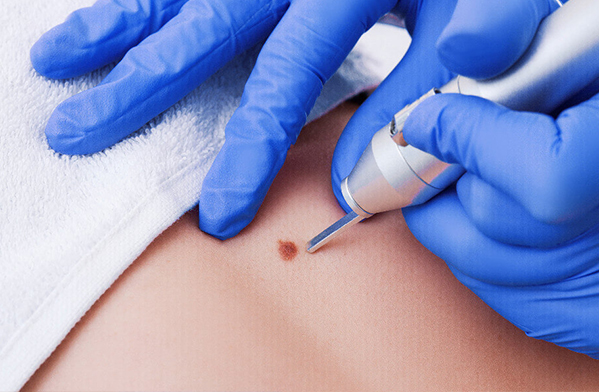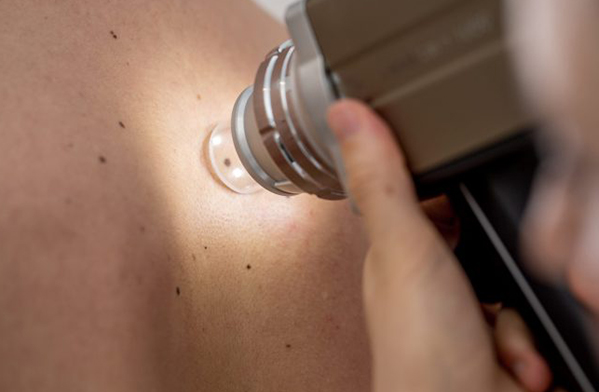REMOVAL OF SKIN NEOFORMATIONS
Pilonidal Cyst
What is it about?
The Pilonidal Cyst or Sinus pilonidalis also called coccygeal / sacrococcygeal cyst or fistula consists of a cyst / fistula that forms at the level of the sacrum and which can deepen to the subcutaneous tissue up to the muscular and bone level. The condition develops between the ages of 15 and 30, and is most commonly affected by the male sex. The pilonidal cyst rarely occurs before age 13 and after age 40.
The pilonidal cyst is probably derived from an abnormal embryonic development of the dermis. It is of variable size and can reach 10 cm. Often in the context of their walls they have a sebaceous gland component, a rudimentary hair follicle and elements of sweat glands. Bone and cartilage tissues are also sometimes present.
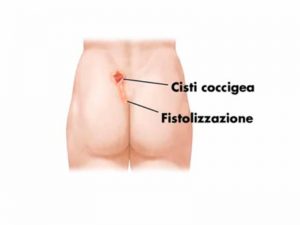
Coccygeal cyst with skin fistula.
Predisposing Factors:
- Ethnicity: Caucasian
- Hirsutism (abnormal hair growth in females)
- Sedentary lifestyle
- Obesity
- Use of cortisone (for example in asthma)
- Familiarity
- Work activity (jeep desease in the US military)
- Trauma on the sacro-coccyx
- Sport (rowing, horse riding, cycling)
- Dermatological conditions (acne, boils, eczema)
How do you know you have sinus pilonidalis?
Usually the patient comes to our clinic complaining of the following symptoms:
- Red, sometimes palpable, painful lump
- Erythema
- Fluid loss: serum, blood, pus
- Fever and discomfort
- Recurrent infections
REMOVAL OF SKIN NEOFORMATIONS
Are you interested in laser removal?
What happens on the first visit?
The plastic surgeon during the first visit will perform a careful medical history, that is, looking for the signs and asking the patient how long the symptoms have appeared, if there is familiarity. A careful physical examination follows, with the patient on his stomach in the ointment position, with the help of a delicate probe to identify any fistulas.
Sometimes it may be useful to perform instrumental examinations, such as ultrasound, up to magnetic resonance: the pilonidal cyst in fact, if it deepens, reaches the barrier formed by the sacrococcygeal vertebrae. At this point it tends to expand laterally. For this reason it is good to operate this cyst as soon as possible, to avoid lateral spread, which can complicate closure.
What is highlighted during the visit?
During the visit, the plastic surgeon must emphasize that the percentage of relapses will be inversely proportional to the timeliness of diagnosis and treatment: if we intervene in a timely manner and avoid the spread of the sinus, surgical removal will be decisive; vice versa if we wait too long, allowing the cyst to increase in size, the possibility of a recurrence increases.
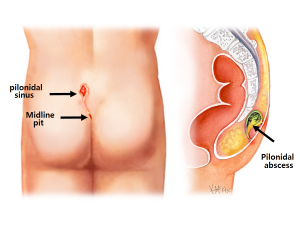
The pilonidal cyst present at the sacral level.
What does the intervention consist of?
The surgery must be performed in a “cold” cyst, ie silent, that is, not infected. In fact, if a pilonidal cyst is infected, the only treatment to be done in urgency is its incision and drainage through the skin of the secretions.
Surgery in elections, on the other hand, consists in the removal of a lozenge of skin and the subcutaneous tissue of the cyst. To understand the depth level of the cyst before the incision, we usually inject a dye (usually methylene blue) through the fistulous medium usually present on the skin surface to map the path of the cyst at the level of the deep layers of the muscle and verify its depth. Not infrequently, in fact, the pilonidal cysts deepen up to the sacrum / coccyx. We are therefore guided in the removal knowing how much tissue to remove to avoid recurrence.
What happens after the removal?
After removal, we usually usually close the wound directly, with careful suturing by layers, from the periosteum / muscle layer to the subcutaneous and subdermal tissue. Some colleagues do not suture and leave the wound open, but we are convinced that the layering technique is by far preferable to ensure a better course and faster wound healing.
What kind of anesthesia is used?
This surgery is performed under spinal anesthesia, with a puncture at the level of the lumbar spine that allows the patient not to feel any pain during the surgery. In addition, local anesthesia is also performed at the treatment site, to reduce post-operative pain, which is however minimal and easily manageable with common oral pain relievers.
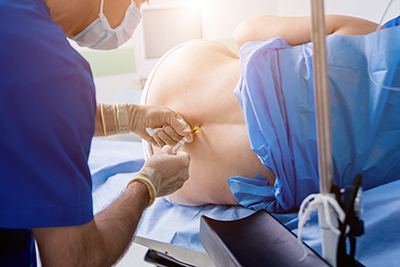
The surgery is performed under spinal anesthesia.
What is the post-operative course?
After the surgery, the patient usually stays overnight for observation. The next day he can be discharged at home. He will then come to our clinic once or twice a week to perform the checkups and medications. Rest from the proceedings is recommended physical life for about 30 days, to avoid increasing tension in the buttocks and to allow wound healing without complications.

Dr. Cesare Cappellina is a Specialist in Plastic Surgery He practices his profession in Vicenza.
